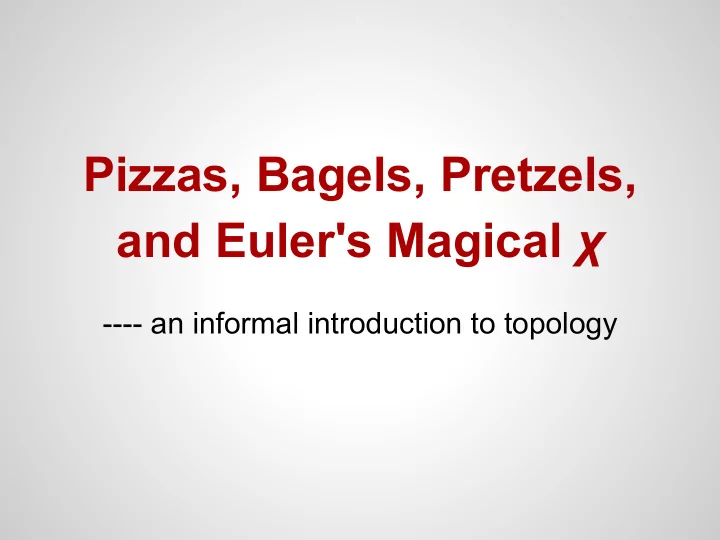

Pizzas, Bagels, Pretzels, and Euler's Magical χ ---- an informal introduction to topology
What is topology? Given a set X , a topology on X is a collection T of subsets of X , satisfying the following axioms: 1. The empty set and X are in T . 2. T is closed under arbitrary union. 3. T is closed under finite intersection. Equivalent definition: Given a set X , a topology on X is a collection S of subsets of X, satisfying the following axioms: 1. The empty set and X are in S . 2. S is closed under finite union. 3. S is closed under arbitrary intersection.
...Another equivalent definition: Given a set X , a topology on X is an operator cl on P(X) (the power set of X ) called the closure operator, satisfying the following properties for all subsets A of X: 1. Extensivity 2. Idempotence 3. Preservation of binary unions 4. Preservation of nullary unions If the second axiom, that of idempotence, is relaxed, then the axioms define a preclosure operator.
What really is topology? Topology is : "Gummy geometry" ≅ ≅ ≅ It’s MY geometry! No tearing ≇ No glueing ≇
More examples ≅ : ≅ ≅ vs. ≇
Topological invariants: ● holes & cavities ● boundaries & endpoints ● connectedness ("in one piece") ● etc... Not topological invariants: ● size ● angle ● curvature ● etc...
≇ ≇ ≇ Classify boldface capital letters up to “topological sameness”: ● G,I,J,L,M,N,S,U,V,W,Z,C,E,F,T,Y,H,K,X ● R,A,D,O,P,Q ● B
Question: ? ≅ They cannot deform into each other in the 3-D space, but they can if you put them in a 4-D space. Hence they should be considered as the same topological object (“homeomorphic” objects). They just sit ("embed") differently in the 3-D space. Mathematical rigor is needed at some point to help our intuition!
Knot theory Same (“homeomorphic”) ≅ in general topology Different in ≇ knot knot theory Trefoil knot Unknot
Applications of knot theory
Surfaces: compact 2-dimensional manifolds with boundaries
These are not surfaces in our sense:
Operations on surfaces: 1. Adding an ear 2. Adding a bridge Bridge ● attached to one ● attached to two boundary boundaries ● increases β by 1 ● decreases β by 1 (β = number of boundaries)
3. Adding a lid + Lid = A lid can be attached to any boundary + Lid = Decreases β by 1
How to make a torus (the surface of a bagel)? Torus = disk + ear + bridge + lid Annulus
4. Twisted ear The Möbius strip Adding a twisted ear does not change β
The Möbius strip is unorientable: no up and down! Möbius Strip by Escher
Escher's paintings
The Möbius strip The Möbius Resistor
Other unorientable surfaces + Lid = (The real projective plane) + Lid = The Klein Bottle Neither can embed into the 3-D space!
The Klein bottle in real life
Twisted bridge & more complicated surfaces Fact: All surfaces can be built this way.
Topological invariants for surfaces: ● number of boundaries β ● orientability: can we distinguish between inside and outside (or up and down)? ● the Euler characteristic
The Euler characteristic χ ● V(ertices) = 5 ● E(dges) = 5 ● F(aces) = 1 χ := V - E + F = 1 ● V = 9 ● E = 10 ● F = 2 χ := V - E + F = 1 A polygon complex
How does χ change when we add a polygon? ● ΔV=4 ● ΔE=5 ● ΔF=1 Δχ := ΔV - ΔE + ΔF = 0 Theorem: χ = 1 for all planar complexes with no "holes".
χ = 0 In general, a planar complex with n holes has χ = 1 - n .
We may also define χ for other (not necessarily planar) complexes: χ = 2 χ = 2 χ = 1
That’s all very nice, but what’s so magical about χ anyway? Theorem: χ is a topological invariant! χ = 2 χ = 1 Proof: Trivial. Left as an exercise.
Δχ Δβ Adding an... -1 +1 ● Ear -1 -1 ● Bridge ● Twisted ear -1 0 ● Twisted bridge -1 -1 ● Lid +1 -1 χ = 0 χ = - 4 χ = 0
Question: What values can χ take? Answer: χ ≤ 2 In fact, β+χ ≤ 2 Theorem: The pair (β,χ) classifies all orientable surfaces. Non-orientable surfaces? They are classified by (β,χ,q) where q=0,1,2 measures non-orientability.
Some mathematical applications of χ 1. Regular polyhedra 2. Critical points 3. Poincaré–Hopf theorem 4. Gauss-Bonnet formula
Regular polyhedra Theorem: These are the only five regular polyhedra.
A soccer ball needs 12 pentagons
Vector fields
Index of singularities
Poincaré–Hopf theorem: Σ(indices of singularities) = χ Corollary: Any vector field on a sphere has at least two vortices. Corollary: Any "hairstyle" on a sphere has at least two vortices (cowlicks). Corollary: At any time, there are at least two places on the earth with no winds.
References: 1. Wikipedia! 2. Topology of Surfaces by L. Christine Kinsey Thank you!
Recommend
More recommend